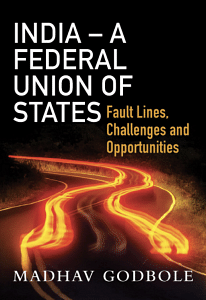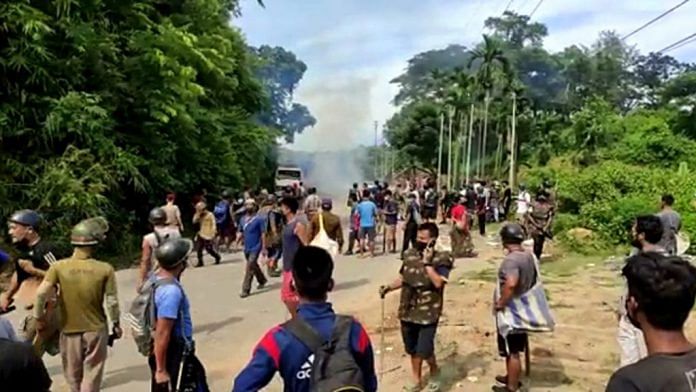One striking example of intensified sub-nationalism is raising of slogans by MLAs and MPs about the greatness of their state, language or historical state icons, after taking the solemn oath in legislature or Parliament. The rulings by presiding officers to desist from doing so, are openly resisted and opposed.
Though movies are certified by the Central Film Censor Board of the GOI, it is not uncommon to see the states applying their own rules and if any part of a movie is perceived to offend local sensitivities of caste, creed, language or historical figures, movies are banned in the state. The same happens with books. It is becoming increasingly difficult to undertake any creative venture without fear of offending the regional, linguistic and cultural sensibilities. I have been advocating for some time that the Constitution should be amended to forbid state governments from taking such actions.
Manuraj Shunmugasundaram (media spokesperson for DMK) in his article ‘Towards a southern brotherhood’ has written that the rising discontent in South India could revive the idea of ‘Dravidian Cooperation’ once articulated by the DMK founder Annadurai. The conclave of finance ministers of southern states held in Thiruvananthapuram in April 2018 may have laid the foundation of Dravidian Cooperation based on natural sense of sub-nationalism and distinct national identity. The political aspects of the dialogue may include challenging the Centre’s actions on imposition of Hindi or on beef, and the economic agenda could call for a review of the terms of reference of the 15th Finance Commission and its implications for devolution of resources (The Indian Express, 12 April 2018, p. 11).
Reference may be made to the discussions held in Kolkata in March 2018 between Mamata Banerjee, Chief Minister of West Bengal, and K. Chandrasekhar Rao, Chief Minister of Telangana, regarding the formation of a federal front.
Also read: New study finds how Kerala-Bengal decided who to vote for between Centre and state in 2019
Garga Chatterjee (Kolkata-based political commentator) has perceptively written:
If one looks at the map of non-BJP states in the Indian Union, it is the south and the east that form a continuous belt that prevents the spilling over of the [Sangh Parivar] Hindi-Hindu-Hindustan ideology into the holy waters of the Bay of Bengal and the Indian Ocean. This continuity is not incidental. This is the zone of politics of federalism. This is the zone whose absence would have created a Hindu Rashtra called Hindustan with Hindi as its national language in 1947. This is the zone whose presence created the flawed but still nominally federal democratic entity called the Indian Union as it exists. (India Legal, 21 May 2018, p. 21)
These are early warning signs of what lies ahead.
The political clout and leverage of southern states was brought home in the case pertaining to the removal of Justice V. Ramaswamy from the Supreme Court on the grounds of proved misbehaviour under Article 124 (4) of the Constitution. The charges of misbehaviour against the judge were found to have been proved by a committee comprising a judge of the Supreme Court, chief justice of a high court and an eminent jurist. However, when the motion for the removal of the judge was placed before Parliament, it was opposed by MPs from the southern states on the grounds of injustice to their brethren and the then Prime Minister P.V. Narasimha Rao succumbed to political pressure to save his minority government, and issued a whip to the Congress Party members to abstain from voting! As a result, the motion for removal of the judge failed. The founding fathers of the Constitution could never have visualised such blatant disregard of constitutional provisions (Godbole 2011, p. 11).
Sub-nationalism is becoming increasingly intolerant everywhere. During the Cauvery waters agitations, even after the decision of the Supreme Court, regional flare-ups were seen in Karnataka and Tamil Nadu. Even showing of Tamil films was halted in Karnataka during this period.
Bihar too adopted a song titled ‘Bihar, the Garland of India’ as the state song five years ago. The aim was to invoke Bihar identity. Odisha and Bihar have also made demands for their own state flags (The Sunday Guardian, 15-21 July 2018, p. 6).
Meghalaya has seen several instances of ethnic clashes—with Bengalis in 1979, Nepalese in 1987, and Biharis in 1992. As a part of the anti-Citizenship Amendment Act (CAA) agitation, the Confederation of Meghalaya Social Organisations and others have been leading a sustained campaign demanding introduction of the Inner Line Permit regime to regulate the entry of ‘outsiders’ into the state. A new law that will potentially require outsiders to register before entering the state is also being pressed for (Outlook, 16 March 2020, p. 26). There is a large population of Sikhs, belonging to backward classes, who have resided in Shillong for nearly five decades. They are being seen as migrants and are facing increasing antagonism, resulting in violence and lawlessness.
Shiv Sena’s Marathi plank comes alive time and again. In September 2015, Diwakar Raote, the then Transport Minister of Maharashtra, announced that one lakh three-wheeler auto-rickshaw permits would be given only to those who showed evidence of having stayed in Maharashtra for over 15 years and speak Marathi (Loksatta, 16 September 2015, p. 4). Counterpart of Shiv Sena, the Maharashtra Navnirman Sena’s (MNS) firebrand chief Raj Thackeray asked his party workers to burn auto-rickshaws operated by non-Marathis. This led to a repartee by Bihar Deputy Chief Minister Tejashwi Prasad Yadav that Maharashtra was ‘not the fiefdom of anybody’s father’ (The Indian Express, 11 March 2016, p. 5). Raj Thackeray halted the agitation only after drawing a flak from across the country. But he reiterated that almost 70-72 per cent of those issued permits were people hailing from outside the state (The Indian Express, 12 March 2016, p. 5).
Gujarat has decided to reserve 80 per cent of factory jobs in the state only for Gujaratis. This is in spite of a large migrant workforce contributing to Gujarat’s rise as a manufacturing hub. According to the Economic Survey 2016-17, net migration among the 20 to 29-year-old group to Gujarat stood at nearly 3.5 lakh, which was one of the highest among Indian states.
UP has gone a step further by promising that 90 per cent of the jobs in every industrial unit in the state will be reserved for local youth.
Also read: Modi’s centralisation of welfare delivery has a cost that BJP’s state leaders are paying
State pride has, at times, led to unimaginable actions. During the ‘Blue Star’ Army Operation launched in the Golden Temple in 1984 to flush out Bhindranwale and other terrorists, some Sikh soldiers had deserted in protest. Later, they were proceeded against by the Army. The Government of Punjab decided to double the monthly allowance to the deserters and their dependents, and announced grant for fee of their wards in schools and medical colleges (The Indian Express, 11 September 2015, p. 1).
The boundary dispute between Assam and Mizoram and between Tripura and Mizoram led to the suspension of traffic between the states, digging of trenches along the border and even destroying a primary school building on the state border. It is not uncommon to see disputes regarding administrative control over a few border villages between states such as Andhra and Odisha, Maharashtra and Andhra, and between the states in the North East. This has vitiated the atmosphere in the concerned states. Is this the one India we have been talking about? These shocking developments showed the ugly face of provincialism.
The importance of these issues needs to be appreciated in the context of an emerging India in which internal migration is a major driving force speeding up economic development. Ambedkar had rightly said, ‘An ideal society should be mobile, should be full of channels for conveying a change taking place in one part to another.’
The outflow of labour has been mainly from UP, Bihar, MP, Jharkhand, Uttarakhand and West Bengal. The staggering size of inter-state migration and the human problem of their displacement shocked India’s conscience during the long nationwide lockdown due to Covid 19 pandemic. Day after day images of thousands of migrants heading for their home states with their meagre belongings, men, women and children—walking, bicycling, sitting precariously on top of buses, crowding in bullock carts, trucks and railway bogies—brought home the enormity of the suffering of migrant labour in the country. After the partial lifting of the lockdown in most states, shortage of labour emerged as a gigantic problem hampering the normalisation of economic and commercial activity in the country.
The rise of sub-nationalism, domiciliary restrictions and agitations against migrant labour can be a catastrophe and pose serious problems, particularly in labour-intensive sectors such as infrastructure, real estate, small and medium enterprises and so on. The seriousness of the rapidly growing menace of sub-nationalism must be addressed with utmost urgency in the national perspective.
 This excerpt from ‘India – A Federal Union of States: Fault Lines, Challenges and Opportunities’ by Madhav Godbole has been published with permission from Konark Publishers.
This excerpt from ‘India – A Federal Union of States: Fault Lines, Challenges and Opportunities’ by Madhav Godbole has been published with permission from Konark Publishers.



